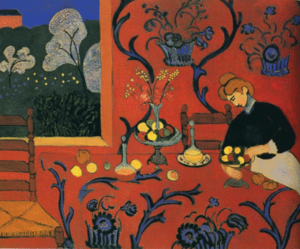Fauvism
|
|

Les Fauves (French for wild beasts), a short-lived and loose grouping of early Modernist artists, emphasized painterly qualities, and the use of deep color, over the representational values retained by impressionism even with its focus on light and the moment. Les Fauves paintings also feature flat patterns and anti-naturalism.
The mantra of the Fauves was a quote from Paul Gauguin to Paul Serusier in 1888 to the effect that if the trees looked yellow to the artist then painted a bright yellow they must be. The name, which translates as "wild beasts," was given the group by an art critic following their 1905 seminal show in Paris. The painter Gustave Moreau was the movement's inspirational teacher, a professor at the École des Beaux-Arts in Paris, who pushed his students to think outside of the lines of formality and to follow their visions.
The leaders of the movement, Moreau's top students, were Henri Matisse and André Derain, friendly rivals of a sort, each with his own followers. The paintings, for example Matisse's 1908 The Dessert or Derain's The Two Barges, use powerful reds or other forceful colors to draw the eye. Matisse became the yang to Picasso's yin in the 20th century while time has trapped Derain at the century's beginning, a "wild beast" forever. Their disciples included Albert Marquet, Henri Manguin, Charles Camoin, the Belgian painter Henri Evenepoel, Jean Puy, Maurice de Vlaminck, Raoul Dufy, Emile-Othonriesz, Georges Rouault, the Dutch painter Kees van Dongen, and Picasso's soul brother Georges Braque.
Fauvism, as a movement, had no concrete theories, and was in itself very shortlived ( they only had three exhibitions). Matisse was seen as a leader of the movement. He himself said he wanted to create art to delight, art as a decoration was his purpose, therefore his use of bright colors tries to maintain serenity of composition. Fauvism simplified lines, whist making the subject of the painting easy to read, and brightened the colors. Among some of the influences of the movement were Gauguin and Van Gogh, both who had begun using colors in a brighter more arbitrary manner.
See also
de:Fauvismus es:Fauvismo fr:Fauvisme nl:Les Fauves ja:フォーヴィスム pl:Fowizm pt:Fovismo fi:Fauvismi sv:Fauvism zh:野兽派
